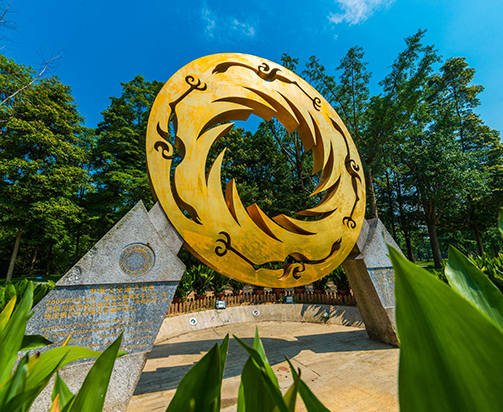Jinsha Site Museum

Jinsha Site Museum
金沙遗址博物馆
Address: 2 Jinsha Site Road, Qingyang District, Chengdu, Sichuan Province
Website: http://www.jinshasitemuseum.com (Chinese)
Hours: 8:00-20:00, 1 May - 31 October (Entry until 19:30)
8:00-18:30, 1 November - 30 April (Entry until 17:30)
Closed days: Closed on Mondays (except for national holidays)
Ticket booking: 028-87303522
Admission: 80 yuan

[Photo/jinshasitemuseum.com]
Walking in the streets of Chengdu, you can’t miss the shining symbol of “golden sun bird”, a golden ring-shaped piece that shows four birds flying in a circle. The item adorns the hoods of every Chengdu taxi cab, decorates every Chengdu metro train, appears on squares in urban Chengdu, and basically serves as an official insignia for the city.
The golden sun bird’s design depicts a circular piece of gold with four birds, all flying in the same counterclockwise direction, located around the perimeter. The center is a sun pattern with twelve points. The symbol celebrates the ancient Jinsha Site, famous for its gold relics from the Shu society.
Covering an area of about five square kilometers, Jinsha Site probably dates back to about 3,000 years ago, the time from the late Shang Dynasty (c.16th-11th century BC) to the early Spring and Autumn Period (770-476 BC). The Jinsha Site Museum was built to protect, study and display the archaeological findings at Jinsha, which were first discovered by archaeologists in February 2001. It contains a Relics Hall, Exhibition Hall, Cultural Heritage Protection Center and Ecological Garden.
More than 200 gold articles, over 2,000 jade pieces of various kinds, and many lifelike stone statues have been found in the site. They include gold foils, gold films, gold masks, Gold Foil of the Sun God Bird; jades in shapes of axes, chisels, knives, swords, spears, rings, and bracelets, as well as kneeling stone figures such as tigers and snakes.
Multi-media interactive devices, performances related to Jinsha Culture, and a beautiful ecological garden harboring ancient trees are also available for visitors. It is a rare Chinese site museum because of its combination of ancient Shu and modern civilization with an ecological environment and culture.
MOST POPULAR
- 1 China to continue opening up its mega-market to world: premier
- 2 Policies concerning expats, foreign enterprises in November 2025
- 3 China to enhance convenience for inbound tourism: minister
- 4 Departure tax refund applications surge 285% as inbound tourism rebounds
- 5 China's foreign trade up 3.6% in first 11 months of 2025







